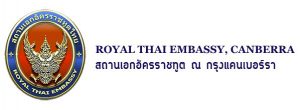About Thai Embassy
Thailand and Australia established formal diplomatic relations on 19 December 1952, after which the Royal Thai Government opened the Royal Thai Legation in 1952 and raised its status as the Royal Thai Embassy in 1955.
History
Initially, the office and residence of the Thai ambassador were located in the same premises and known to the public as “the Royal Thai Legation”. It was located at 47 Melbourne Avenue, Forrest, ACT.
On January 5, 1954, the Thai Government purchased a house at No. 15 Mugga Way, Red Hill, ACT from Colonel Mervyn John Holmes for a sum of 10,000 pounds, to be used as the residence of the Thai Ambassador. The land where the said house was located had been rented from the ACT Government for 99 years. In September 1971, the residence was moved to No. 111 Empire Circuit, Yarralumla, ACT. From 1 April 1954 onwards, the office had moved to No. 1 Fraser Place, Yarralumla, ACT and later to No. 9 Daly Street, Deakin, ACT in November 1965.
The first Ambassador Extraordinary and Plenipotentiary of the Kingdom of Thailand to Australia was H.E. Ambassador Konthi Suphamongkhon, who had an additional four officers at the Embassy. At that time, there was an office for Thai students and a military attaché office in Canberra.
The first official visit to Australia
His Majesty King Bhumibol Adulyadej The Great and Her Majesty Queen Sirikit The Queen Mother, paid an official visit to Australia for the first time from 26 August – 12 September 1962. Their Majesties visited various states of Australia including a visit to the Thai Ambassador’s residence in Canberra, located at No. 15 Mugga Way, Red Hill, ACT on August 28, 1962. During the said visit, Their Majesties granted an audience to H.E. Ambassador Vadhana Isarabhakdi and his wife, as well as other Thai nationals residing in Canberra.
The Ambassador’s Residence
The Ambassador’s Residence’ s construction project was initiated in 1965 during the term of H.E. Ambassador Prasong Bunchoem when the Ministry of Foreign Affairs of Thailand instructed the Embassy to request for a plot of land from the Australian Government, to be allocated for the said construction.
In 1966, the Royal Thai Embassy hired Mr. TN Olgay to draft the Embassy’s building plan for the first time. The Royal Thai Embassy’s building and its unique roof design were later used as a prototype by the Fine Arts Department.
In 1967, the Embassy signed a land lease agreement with the Australian government at Block 7, Section 86, Yarralumla, which is currently No. 111 Empire Circuit, Yarralumla, ACT, for 99 years. The total land area of the said block is approximately two acres (or five rai) of land. Under this lease agreement, the Thai Government has to pay annual land rental fee subjected to appraisal every twenty years.
For the Ambassador’s residence, the foundation stone laying ceremony was held on 11 March 1970 with Meli & Eglitis Pty, Ltd. as the contractor and Mr. TN Olgay as an architect responsible for the project. The construction lasted nearly seventeen months. After its completion, H.E. Ambassador Prasong Boonjem then moved from No. 15 Mugga Way, Red Hill, ACT to the new residence at No. 111 Empire Circuit, Yarralumla on 9 September 1971. On 18 September 1971, His Majesty King Maha Vajiralongkorn Phra Vajiraklaochaoyuhua (then holding the title of HRH Crown Prince Maha Vajiralongkorn) presided over the opening ceremony of the new residence.
As for the chancery, the Ministry of Foreign Affairs of Thailand approved the building modification plan which included accommodation, trackers and garages as temporary offices. The modified chancery was located within the same compound as the Ambassador’s Residence. After the completion, the move to the new office premises was held on 15 August 1971.
Improvement of the Embassy’s chancery in 1996 – 1998
During the tenure of office of H.E. Ambassador Laxanachantorn Laohaphan, the embassy’s main office had undergone another renovation. The construction of a multi-purpose building called “Sala Thai” or Thai Pavillion was built to showcase the beautiful and unique Thai architectural style. The Embassy’s chancery and its functional building were meant to represent national symbol of Thailand. During the construction process, Thai architects had been hired to carry out the design work. All decorative materials for the buildings such as wood, carved walls, glass columns, ceilings and gables were imported from Thailand. The renovation project lasted two years (from 1996 – 1998) with Barclay Mowlem as the contractor and the Bunning and Madden company as the supervisor. In addition, Prof. Bunnak Nakhangluck, former Vice President of the Academic Department, Faculty of Fine Arts, Chiang Mai University and Khun Suthinee Muang Saen, two Thais living in Canberra also assisted in the interior decoration of the buildings to showcase Thai identity. The Sala Thai, in particular, was also intended for use as a place to promote Thai art and culture or as an art gallery to display Thai art works. Inside Sala Thai, beautiful main pillars with gold leaf are shown.
On 14 July 1998, the Royal Thai Embassy held an official opening ceremony of the new office building and Thai Pavilion or Sala Thai, with H.E. Dr. Surin Pisuwan, the late Minister of Foreign Affairs of Thailand together with the Honourable Tim Fischer, Deputy Prime Minister and the Honourable Alexander Downer, Minister of Foreign Affairs of Australia at that time, presiding over the ceremony.
At present, there are three buildings within the Embassy’s compound: the Chancery, the Ambassador’s Residence and the Sala Thai. The Royal Thai Embassy premises has become a landmark for tourists visiting Canberra, and showcases Thai identity in Australia.



